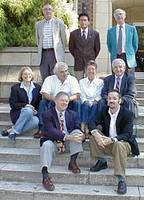In the May 2004 issue of
Crisis magazine, Arlene Oost-Zinner and Jeffrey Tucker have an article entitled "
Fourteen Easy Ways to Improve the Liturgy." In many ways an excellent article, it offers a number of insightful observations on the following fourteen suggestions:
- Turn down the volume.
- Chant for a prelude.
- Curb the announcements.
- Choose plain, traditional hymns for the processional.
- Sing the Kyrie.
- Choose a plainer Gloria.
- Fix the Psalm.
- The Offertory should be a time of preparation.
- Reduce and simplify the 'Mystery of Faith' and the 'Great Amen.'
- Shorten the Sign of Peace.
- Begin the communion chant (a simple Latin hymn will do) after the priest receives.
- Don't force people to sing during communion.
- Allow for silence after communion.
- Don't attempt a rousing good-bye.
In the course of elaborating upon these fourteen suggestions, the authors offer many very significant insights and helpful suggestions. I would recommend the article as something that could be shared profitably with any priest and music director.
But I would add a further suggestion of my own:
This may seem a rather odd and trifling suggestion until one begins to examine it. Anyone who has wandered into inner city churches and cathedrals (whether in the United States, Ireland, Britain, or Europe) at odd times of day will know that they are not usually brightly illumined as suburban American churches are during Masses. Rather, they are usually dim. The only source of light, other than the natural light from the (usually stained glass) windows, is the Tabernacle light, easily spotted as a pinprick of light emanating from the vicinity of the Altar, and perhaps a flickering bank of votive candles, glowing amidst the richly mysterious gloom. By contrast, when they turn on the lights in most suburban American Catholic churches today the lights are so harshly bright that they could serve to illumine a surgical operating room.
In my own parish, I am accustomed to going early to church with my wife, arriving in time to participate in praying a group Rosary in front of the Blessed Sacrament before Mass. The interior of the church, at this point, is still shrouded in a comforting darkness, with only the Tabernacle light signaling the Presence of the Blessed Sacrament near the Altar. Throughout the Rosary, the interior of the church remains thus hushed in relative darkness and quiet, but for the antiphonally recited prayers of the Rosary.
As the Rosary nears its end, people begin filing into the church (in cannot be called the nave, as it is one of those post-Vatican II structures practically built in the round), and suddenly it happens: the klieg lights are thrown on. The whole interior of the church is suddenly bathed in harsh light -- a light that casts out all shadow, and, with it, all mystery, all quietude. It is as if Channel 9 Action News has entered the sanctuary with its carbon arc lamps and cameras and brought the whole secular world from outside in with it.
But there is something else I notice. Something else is lost: the orientation and focus of worship. Before the lights are thrown on, the focus is where it belongs: up where Christ Himself is uniquely Present, where His Presence is signaled by the Tabernacle light and His place of Sacrifice is signaled by the illuminated Altar. The focus is not on those of us who are back in our pews saying the Rosary. We remain shrouded in shadow, only our voices rising out of the darkness to attest to our presence. But the moment the bright klieg lights are thrown on, everything is changed. The whole interior of the church illuminated like a stage -- not only that part of it containing the Altar and Tabernacle, which used to be called the Sanctuary, but that part of it containing the pews and parishioners, which used to be called the Nave. Traditionally the Communion Rail marked the boundary dividing the Sanctuary from the Nave; but this boundary has disappeared from most American Catholic churches along with most other boundaries demarcating any division between the sacred and the profane. And the bright contemporary illumination of the whole interior of churches is another instance of this erasure of boundaries. And notice what happens: when everything is equally bathed in uniform white light, the neck of the person sitting i front of you, with all of its creases, warts, and freckles, is as brightly illumined as the Tabernacle or the priest at the Altar. The result? A loss of orientation and focus.


 This just in from the Polish Prince via the "Episcopal Spine of Steel Alert" at Ad Limina Apostolorum: Three southern bishops (pictured, left-to-right, the Most Reverend Peter J. Jugis, Bishop of Charlotte; the Most Reverend Robert J. Baker, Bishop of Charleston, SC; and the Most Reverend John F. Donoghue, Archbishop of Atlanta) issued the following Joint Statement:
This just in from the Polish Prince via the "Episcopal Spine of Steel Alert" at Ad Limina Apostolorum: Three southern bishops (pictured, left-to-right, the Most Reverend Peter J. Jugis, Bishop of Charlotte; the Most Reverend Robert J. Baker, Bishop of Charleston, SC; and the Most Reverend John F. Donoghue, Archbishop of Atlanta) issued the following Joint Statement: 








